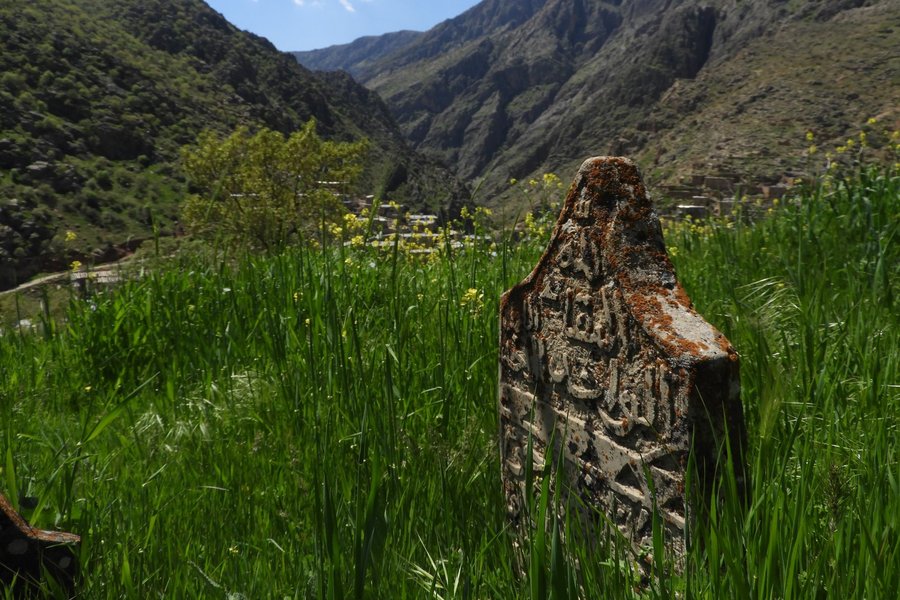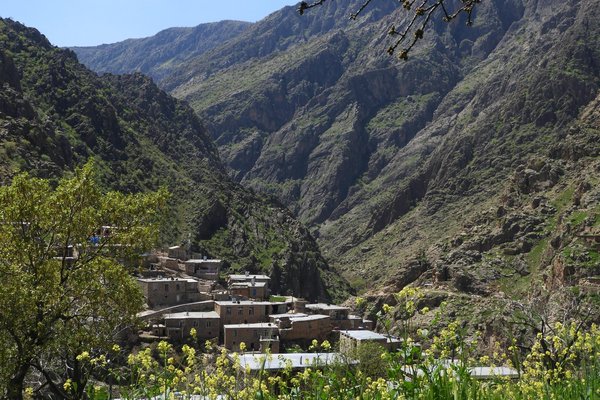Iran
Hawraman/Uramanat
The Cultural Landscape of Hawraman/Uramanat bears testimony to the traditional semi-nomadic agropastoral way of life of the Hawrami people.
The landscape comprises agricultural villages and their lands in two valleys in the Zagros mountains. The semi-nomadic inhabitants perform steep-slope agriculture using traditional dry-stone terracing and water management practices.
Community Perspective: Zoë mostly enjoyed the journey through the valleys.
Site Info
Official Information
- Full Name
- Cultural Landscape of Hawraman/Uramanat (ID: 1647)
- Country
- Iran
- Status
-
Inscribed 2021
Site history
History of Hawraman/Uramanat
- 2021: Inscribed
- Inscribed
- Type
- Cultural
- Criteria
- iii
- v
Links
- UNESCO
- whc.unesco.org
All Links
UNESCO.org
- whc.unesco.org — whc.unesco.org/
Community Information
- Community Category
- Cultural Landscape: Continuing
Travel Information
Red Zone Travel Advisory
Iran fully off-limits
Recent Connections
-
Golden jackal
"Among animals found in the region are…
-
Perfect Inscriptions
2021 -
Neanderthals
"Given the fact that human fossils of t…
Connections of Hawraman/Uramanat
- Geography
-
-
Tigris - Euphrates Basin
“is primarily located within the Sirwan River Basin. The Sirwan River is a significant river that flows through the heart of the Hawraman/Uramanat region, creating a vital ecosystem in its valleys. Most of the springs and rivers in the Hawraman area ultimately contribute their water to the Sirwan River. The Sirwan River is a major tributary of the Diyala River, which eventually flows into the Tigris River” -
Kurdistan
Irani Kurdistan
-
- Trivia
-
-
Minority communities
"The remote and mountainous landscape of Hawraman/Uramanat bears testimony to the traditional culture of the Hawrami people, an agropastoral Kurdish tribe that has inhabited the region since about 3000 BCE." (Official description) -
Largest cultural WHS
106,307 ha
-
- History
-
-
Neolithic age
The vertical migration pattern in Hawraman/Uramanat is among the oldest types of migration, dating to the early Neolithic. (AB ev) -
Sassanid Empire
"Construction of several bridges as well as expansion of local roads particularly under the Sassanid dynasty are expressive of the significance of the region in historical times. There are so many sites in the region which can confirm this." (Nomination file, p. 135) -
Neanderthals
"Given the fact that human fossils of the era have been found in Bisotun and Shaeeder caves, inhabitants of the time were probably Neanderthal men who have become extinct since about forty thousand years ago." (Nomination file, p. 38) -
Achaemenid Empire
"As part of the Achaemenid territory (the Medes Satrapy) Hawraman/Uramanat region also enjoyed a relative tranquillity until the demise of the Achaemenid empire." (Nomination file, p. 134) -
Assyrian Empire
"(...) the region was occupied by the Assyrians during their military campaigns into the Zagros." "(...) in an inscription found in Palangan Village, the Assyrian invasion and conquest of the region has been fully described showing that the region was vulnerable to direct attack from alien or neighboring forces making a strong effect on the architectural structure of villages." (Nomination file, p. 37, 82) -
Bronze Age
Central-Eastern Valley: "The earliest archaeological findings show than man settlements in these area date back to the late Bronze and Iron Ages." (Nomination file, p. 102)
-
- Ecology
-
-
Salamanders
Kurdistan newt (Neurergus microspilotus) (AB Ev – IUCN) -
Bears
"Among animals found in the region are: (...) bears" (Nomination file, p. 35) Brown bears in the Kosalan and Shahu Protected Areas (Nomination file, p. 223) -
Otters
"Among animals found in the region are: (...) Eurasian otter" (Nomination file, p. 35) -
Pelicans
Dalmatian pelican (Nomination file, p. 35) -
Critically endangered fauna species
The property "overlaps with the range of at least one Critically Endangered species on the IUCN Red List of Threatened Species, the Kurdistan Newt (Neurergus microspilotus)." (AB Ev – IUCN) (it's a salamander) -
Gray Wolf
"Hawraman is home to divers fauna, including (...) wolf (Canis lupus) (...)."See en.wikipedia.org
-
Turtles and tortoises
"Among animals found in the region are: (...) various kinds of turtles and snakes" (Nomination file, p. 35)
-
Eagles
Golden eagle (Nomination file, p. 35) -
Golden jackal
"Among animals found in the region are: (...) jackals" (Nomination file, p. 35)
-
Steppe
"In addition to the valleys, high mountain ridges, steep-sided valleys, and rivers, the nominated property includes many other natural values, such as chestnut forests, scrubby woodland, and steppe habitats." (AB Ev – IUCN)
-
- Architecture
-
-
Vernacular architecture
"The cultural landscape made up of villages of steep-slope vernacular architecture" (AB Ev – ICOMOS) -
Dry Stone Construction
gardening on dry-stone terraces (AB ev) -
Cave dwellings
"Archaeological excavation in rock shelters and caves located in the Sirvan river valley of Kurdistan Province have led to the discovery of evidence belonging to stone-age hunters and early cave dwellers." (Nomination file, p. 37) "A total of 45 caves and cliff shelters have been identified in Hawraman/Uramanat. Most of these caves are natural but a few have been altered due to human intervention. (...) it can be strongly claimed that cave-dwelling in Hawraman/Uramanat has a long history whether permanent or temporary." (Nomination file, p. 130)
-
- World Heritage Process
-
-
Perfect Inscriptions
2021
-
- Religion and Belief
-
-
Sufism
"Tekyehs and Khaneqahs as places of praying and worshipping for dervishes and Sufis enjoy a high rate of local popularity. (...) Among well-known Tekyehs and Khaneqahs which can also be regarded as Sufi monasteries, are sheikh Ahmad Khaneqah in Abbas Abad village, Sheikh Hadi Tekyeh in Doulab Village and Shamsolarefin Khaneqah dating from over 150 years ago in Najar village." (Nomination file, p. 51) -
Zoroastrianism
"(...) based on Persian literature it can be concluded that Hawraman/Uramanat was a land in which sun-worshippers lived and as we know during the reign of the Achaemenid empire, Zoroastrianism was popular in the area." (Nomination file, p. 49) "Some scholars believe that the name Hawraman or Huraman has strong connections to the ancient Zoroastrian faith and claim that the name may have originated from Ahuraman or Ahura Mazda. (...) Many areas in the Avroman region are believed to have been pilgrimage sites for Zoroastrians prior to the advent of Islam."See en.wikipedia.org
-
- Human Activity
-
-
Man-made Terraces
"Among major ancient innovations in Hawraman/Uramanat is the clever technical terracing in mountain slopes. The intelligent method of setting up these terraces and their creative architecture shows wisely observance of structural, architectural and scientific principles beside an innovate construction of water drainage system and foundation. Some of these terraces dates back to hundreds of years ago but they are still intact and functioning." (Nomination file, p. 73) -
Transhumance
seasonal vertical migration (AB ev) -
Pastoralism
The property is therefore said to present important evidence in the context of the history of pastoral migration. (AB ev) -
Irrigation and drainage
"The Hawrami people's endeavors, exquisite and skillful agricultural technology, and ecological world-view taken from ancestral practices have successfully created a smart, efficient, fair, harmonious, and sustainable agricultural system that manages water and irrigation and pinpoints proper dwelling spaces." (AB Ev – ICOMOS) "(...) irrigation and optimal water management in Hawraman/Uramanat gardening is quite creative and shows signs of the development of human knowledge in exploiting limited natural resources of Hawraman/Uramanat." (Nomination file, p. 72-73) -
Petroglyphs
"tangible features include caves, archaeological sites, mounds, citadels, historic cemeteries, rock carvings and petroglyphs, historic roads, villages, and Havars" (AB Ev – ICOMOS) "Carved patterns (...) can be divided into four groups of humans, animals, geometrical (symbolic) and hybrid (human-animal) shapes". (Nomination file, p. 42) -
Festivals
Pir-e Shaliar festival
-
- Constructions
-
-
Cemeteries
"Archaeological findings dating back about 40,000 years, caves and rock shelters, ancient paths and ways along the valleys, motifs and inscriptions, cemeteries, mounds, castles, settlements, and other historical evidence attest to the continuity of life in the Hawraman/Uramanat region from the Paleolithic to the present time". (Official desription)
-
- Timeline
-
-
Built in the 7th millennium BC
The vertical migration pattern in Hawraman/Uramanat is among the oldest types of migration, dating to the early Neolithic. (AB ev) Late Neolithic (c. 7000–5000 BCE). (wiki)
-
- Visiting conditions
-
-
Red Zone Travel Advisory
Iran fully off-limits
-
News
No news.
Recent Visitors
- henryjiao18
- Roman Bruehwiler
- Ask Gudmundsen
- Zoë Sheng
- Erik Jelinek
- Afshin Iranpour
- Alexander Barabanov
Visitors of Hawraman/Uramanat
Community Reviews
Show full reviews
I was driving here in the off-season which isn't a good idea in general. This is off a small road leading from Kermanshah to Sanandaj and there wouldn't really be any reason to go here but for the world heritage site. It doesn't usually drop below zero Celsius much here and you shouldn't expect snow but it's still quite chilly. You can see the valleys from this road. The actual spot to visit is called Palangan Tourist Village just aside this road. It is made very touristy on purpose although the Kurdistan formalities don't mean it's tacky or selling out. Because I came in the off-season nobody was really here or expecting tourists. The main point of interest will be viewing the valley plus the houses that rise up the mountain. I've seen similar in Saudi Arabia just definitely not with the Kurdistan ethnicity. Normally there are sellers with shoes, cloths and other baskets, snacks among the collected food, but everyone was staying home during my visit.
Palangan Rural Museum was open and it shows off some tools as well as medical plants found nearby. It helps to understand people do around here a bit better but not really worth the trip. The journey through the valleys, as treacherous as the roads are, was definitely better.
Keep reading 0 comments
